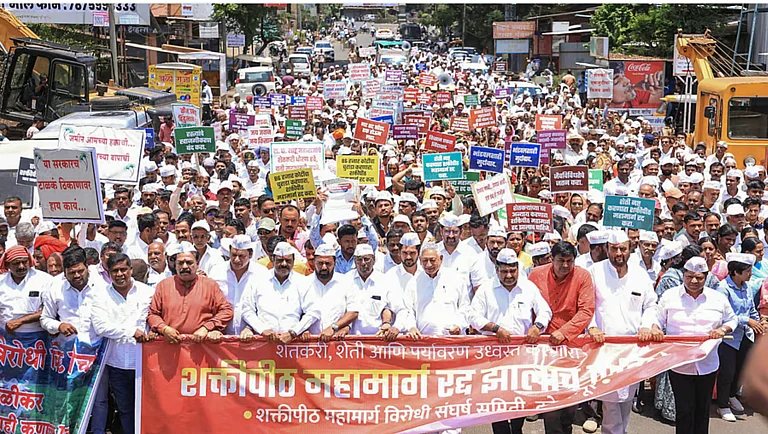At India Maritime Week 2025, Maharashtra took center stage as leaders from the state government, port authorities, and the private sector came together to chart the course for India’s next big leap in maritime infrastructure — the Vadhvan Port Project. The session, highlighting Maharashtra’s unprecedented participation in a central government initiative, underscored how public-private collaboration and sustainable planning are shaping India’s maritime future.
As the keynote speaker, Chief Minister of Maharashtra, Devendra Fadnavis addressed the audience, "With the signing of 13 strategic MoUs today, Maharashtra takes a decisive step towards becoming the maritime superpower of India. These partnerships will drive excellence across technology, human resources, and systems — strengthening our shipbuilding and repair infrastructure, developing efficient water transport, and integrating with the global supply chain. Our goal is to create a future-ready maritime ecosystem that saves time, reduces costs, and enhances connectivity for both people and cargo. The introduction of clean, electric water taxis from the new airport to the Gateway of India is a step in that sustainable direction. With the strong support of our Hon’ble Prime Minister, we are unlocking the immense potential of the blue economy, and I am confident that Maharashtra will lead India’s maritime growth for the next fifty years — joining the ranks of the world’s top ten ports and setting benchmarks for innovation and development."
Mr. Nitesh Rane, Hon’ble Minister of Ports & Fisheries, facilitated the agreements and signing of the MoUs for the Vadhvan Port Project, and expressed his heartfelt vote of thanks to all the stakeholders for their support and collaboration. For the first time, a state government has taken equity in a central government port project — a move that marks a milestone in cooperative federalism and the state’s proactive approach to infrastructure growth.
Speaking at the session, Shri Sanjay Sethi, IAS, ACS (Transport & Ports), representing the Government of Maharashtra, said, “This is the first time a state government has taken equity in a port project. Maharashtra is proud to lead this step forward. Our investment is not just financial — it’s a commitment to employment generation, industrial development, and connectivity. The Nashik–Vadhvan road project will be a major link driving regional growth, connecting industrial belts and developing new economic centres.”
He further emphasized how the greenfield airport and industrial corridors around the Vadhvan region will transform the area into a vibrant economic hub, catalyzing long-term socio-economic development.
Adding to this, Shri Unmesh Sharad Wagh, Chairman, Jawaharlal Nehru Port Authority (JNPA), shared insights into JNPA’s expertise and readiness to take on the ambitious project: “Vadhvan can be developed efficiently under JNPA’s guidance — we bring years of experience in building liquid and container terminals, and our global performance ranking among the top 20 container ports stands testimony to that. Reclamation will be a key feature here, and JNPA’s technical proficiency ensures it’s done sustainably. Our focus remains on capacity-building — training the next generation in warehouse development, CFP training, and working in harmony with local communities.”
He also noted that green hydrogen-based liquid ports and hydro bunkering capabilities are part of the long-term sustainability roadmap.
Mr. Pranav Choudhary, CEO (Ports), Adani Ports and SEZ, who led the discussion on technical design and resilience, outlined the complexities of the Vadhvan Port development: “A port is one of the most complex infrastructure projects to design and deliver. Every alignment, reclamation strategy, and environmental factor is being critically analysed to ensure the most efficient and disaster-resilient port. Community engagement has been central to our approach — ensuring that local livelihoods and participation remain integral. With strong digitalisation and robust connectivity, we are building a future-ready port system.”
Representing the private sector, Mr. Rinkesh Roy, CEO & Joint Managing Director, JSW Infra highlighted the importance of industry-government synergy and skills development: “The support extended by government bodies has been exceptional. The private sector sees immense opportunity in this development — not only in infrastructure but also in human capital. We need to train and empower the next generation with the skills required for port management, logistics, and digital systems. Creating a complete ecosystem — from industrialisation to evacuation plans and technology enhancement — is essential to achieve maximum outcomes.”
Mr. Madhu S Nair, Chairman & Managing Director, Cochin Shipyard Limited adding on to Maharashtra: Spearheading India's Shipbuilding Ambitions said, “For India to compete globally in maritime infrastructure, productivity, efficiency, and effectiveness must work hand in hand. Our focus should be on aligning pricing, scope, and timelines — the very formula that propelled Japan, Korea, and China to maritime excellence. True success lies not just in building the port, but in engineering, planning, and establishing processes that ensure a sustainable ecosystem for generations to come.”
Together, the speakers echoed a unified vision: to build a world-class port ecosystem in Maharashtra that balances growth, technology, and sustainability.
With Vadhvan Port poised to become one of India’s largest and most advanced maritime hubs, the Maharashtra Government’s strategic involvement reaffirms its leadership in driving transformative infrastructure that empowers industries, communities, and the nation’s blue economy.


























